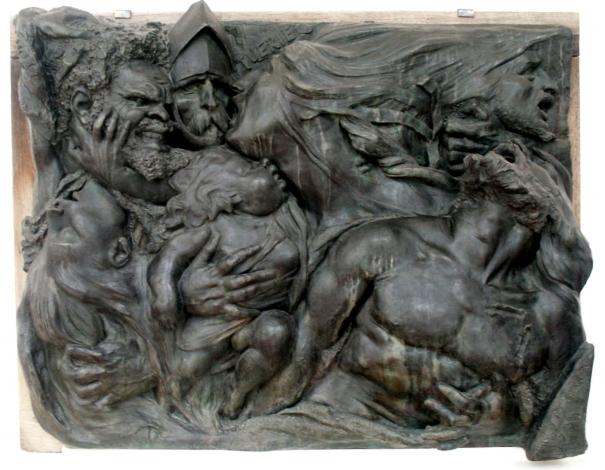Tuerie (Slaughter)
Jonathan Ribner suggests that Préault’s Tuerie was a direct response to another contemporary sculpture:
“While Tuerie is surely an extreme example of the Romantic fascination with suffering, it is possible to argue for a more specific point of departure. It is my contention that Tuerie was conceived as a pessimistic revision of Henri de Triqueti’s glorification of the civilizing force of law in his pair of reliefs decorating the Salle Louis-Philippe [in the Palais Bourbon, Paris].
The visual evidence suggests the Préault, who exhibited the plaster version of Tuerie in the Salon of 1834, was familiar with Triqueti’s Salle Louis-Philippe reliefs, commissioned the previous year. There are a number of telling similarities between Tuerie and Avenging Law. Principal among these is the resemblance of the hysterical mother (at the center of Tuerie) to the female victim at the right of Avenging Law who, with hair streaming behind her, wildly seeks the protection of a winged avenger. In addition, the fury of Triqueti’s sword-bearing avenger is echoed in a male profile in the upper-right corner of Tuerie; the bearded thief on the left side of Avenging Law offers a conventional point of departure for the extravagantly grimacing African face in the upper-left corner of Tuerie; and the baby in Tuerie seems an unfortunate cousin of the doughy-limbed child who lies at its mother’s breast in Protecting Law. Particularly suggestive is Préault’s placement of the word ‘TUERIE’ in a position similar to that of the inscription ‘LEX’ [law] on the Mosaic tablets in Triqueti’s reliefs. This is a verbalization of the subversive impulse from which Tuerie originated: an officially consecrated myth – the triumph of order, justice, and civilization under the aegis of law – is transformed into an evocation of chaotic and blind slaughter.
This reading of Tuerie is entirely in accord with Préault’s notoriously caustic wit, characteristically directed against authority and established taste.”
Jonathan P. Ribner, “Henri de Triqueti, Auguste Préault, and the Glorification of Law under the July Monarchy,” The Art Bulletin, vol. 70, no. 3 (September 1988): 497.
About the Artist
Died: Paris, 11 January 1879
Nationality: French


 Buy the Book
Buy the Book